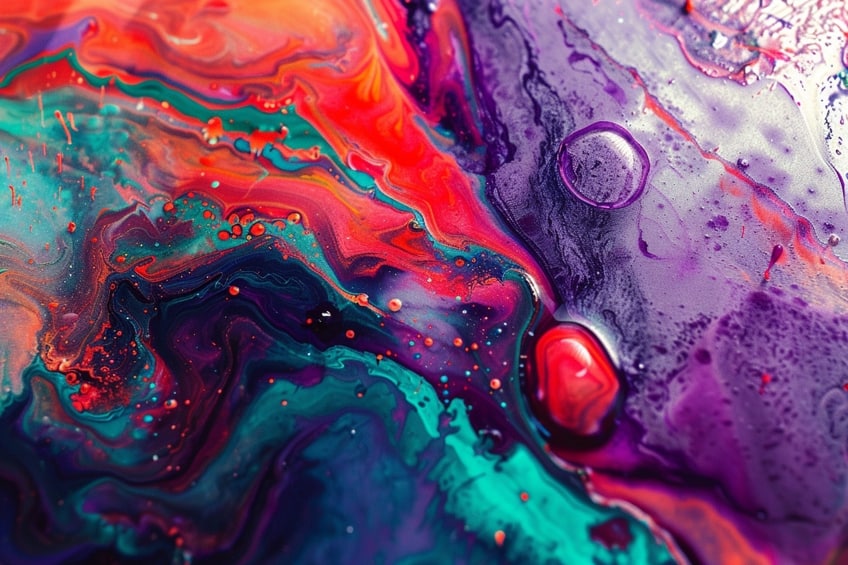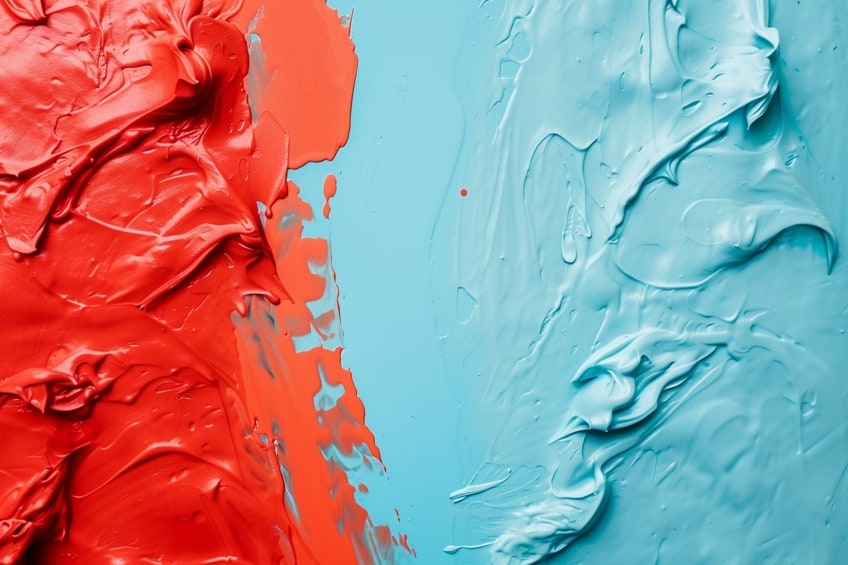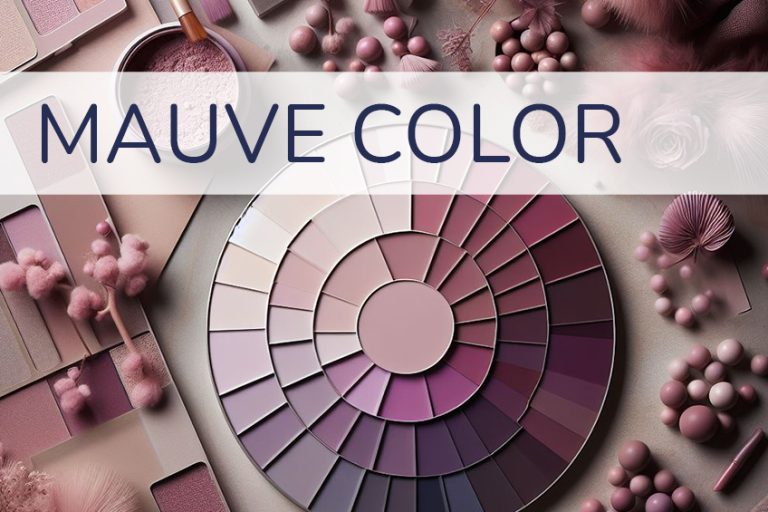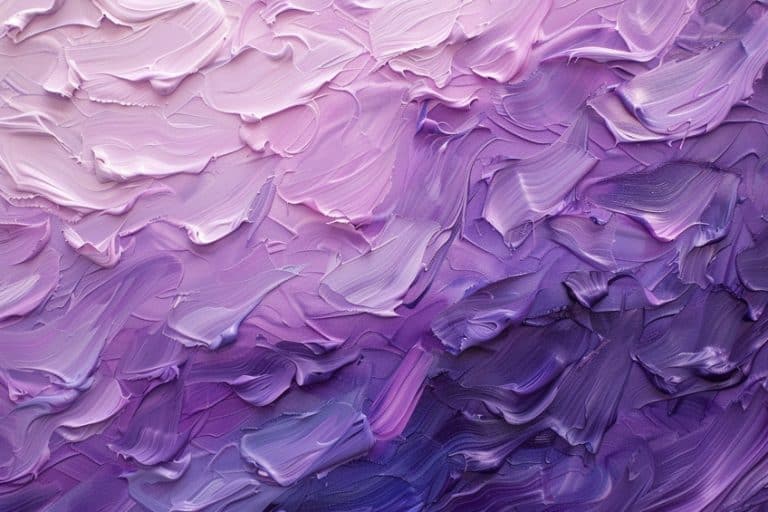Opposite of Red – Finding Red’s Contrasting Color
Welcome, fellow color enthusiasts! Today, we embark on a vibrant journey into the kaleidoscopic world of hues, focusing our gaze on the tantalizing opposite of red. As we dive into the chromatic depths, prepare to unlock the secrets of its complementary counterpart, a shade that ignites the imagination and dances on the canvas of our minds. Get ready to embrace the harmony and discord, the tension and balance, as we unravel the captivating tale of the color spectrum’s most daring duo: red and its enigmatic opposite. So, grab your palette and let’s paint the town… well, not red, but its thrilling antithesis!
Key Takeaways
- Red’s opposite color varies by color model: cyan in RGB, purple in CMYK, and green in RYB.
- Complementary colors enhance contrast and are pivotal for design, art, and color reproduction.
- Identifying correct opposites requires understanding different color models and their applications.

Understanding Complementary Colors
| Shade | Hex Code | CMYK Color Code (%) | RGB Color Code | Color |
| Red | #FF0000 | 0, 100, 100, 0 | 255, 0, 0 |
When it comes to colors and their relationships, the concept of opposite or complementary colors is a fundamental element of color theory. In various color models, the opposite of red is identified differently. For instance, in the RGB (Red, Green, Blue) color model, which is used for digital screens, the opposite of red is cyan. This is because cyan is a mixture of green and blue light, which, when combined with red light in the RGB model, creates white light.
In the realm of print, however, where the CMYK (Cyan, Magenta, Yellow, Black) model is prevalent, the complementary pairings shift slightly due to the subtractive nature of color mixing with inks.

Here, the colors opposite to red are composed of cyan and magenta, yielding a purple shade in practice. Furthermore, in the RYB (Red, Yellow, Blue) color model, which is traditional for art and design, red’s opposite is often cited as green. This spectrum of opposite colors is essential in creating visually appealing designs, art, and accurate color reproduction across different media. Complementary colors are pivotal in color theory, serving as a fundamental concept for artists and designers to create visually appealing contrasts and harmony in their works.
Applying Opposite Colors in Art
When artists refer to opposite or complementary colors, they generally focus on the color wheel, which represents the spectrum of colors in a circle. Red is directly across from green on the color wheel, making them complements to each other. This relationship is crucial for creating contrast in painting and design. Similarly:
- Yellow is the complement of purple.
- Blue pairs with orange.
When complementary colors are placed side by side in art, the contrast is enhanced, making each color appear more vivid. This technique allows artists to guide the viewer’s attention to specific areas of a painting.
- Red and green: Energizing contrast, often used during holiday themes
- Blue and orange: Warm and cool contrast, popular in landscapes
- Yellow and purple: Lively and royal contrast, used for emphasis
Complementary colors also play a role in mixing paints. By adjusting the proportions of complementary hues, artists can create a variety of neutral tones, shades, and shades to achieve a balanced and harmonious piece of art.
Different Color Models
Color models provide a systematic approach to creating a wide spectrum of colors. They define how primary colors mix to produce additional colors, including what is perceived as the opposite, or complementary, color to red.

What Is the Opposite of Red in RGB?
| Shade | Hex Code | CMYK Color Code (%) | RGB Color Code | Color |
| Red | #FF0000 | 0, 100, 100, 0 | 255, 0, 0 | |
| Cyan | #00FFFF | 100, 0, 0, 0 | 0, 255, 255 |
In the RGB (Red, Green, Blue) color model, which is an additive color model primarily used in digital screens and photography, the opposite of red is cyan. Cyan is produced by mixing full intensity of green and blue light and no red light.
What Is the Opposite of Red in CMY?
| Shade | Hex Code | CMYK Color Code (%) | RGB Color Code | Color |
| Red | #FF0000 | 0, 100, 100, 0 | 255, 0, 0 | |
| Cyan | #00FFFF | 100, 0, 0, 0 | 0, 255, 255 |
The CMY (Cyan, Magenta, Yellow) model is a subtractive color model, commonly used in color printing. In this model, the opposite of red, which is a mixture of magenta and yellow, is produced by adding cyan, making cyan the complementary color of red.

What Is the Opposite of Red in RYB?
| Shade | Hex Code | CMYK Color Code (%) | RGB Color Code | Color |
| Red | #FF0000 | 0, 100, 100, 0 | 255, 0, 0 | |
| Green | #00FF00 | 100, 0, 100, 0 | 0, 255, 0 |
RYB (Red, Yellow, Blue) is a color model historically used by artists and in educational settings. It is also known as the artistic color wheel. In the RYB color model, the contrasting color to red is green. Green is obtained by mixing yellow and blue, the other two primary colors in the RYB model.
How to Find the Correct Opposite to Red
Identifying the correct opposite, or complementary, color to red depends on the color model or system in use. In the RGB (Red, Green, Blue) color model, which is used for electronic displays, the opposite of red is cyan. This model operates on an additive principle, where colors are created by combining light of these three primary colors. For print media, the CMYK (Cyan, Magenta, Yellow, Key/Black) system applies. Here, the colors are subtractive, starting with white and subtracting light to create color. In CMYK, cyan is still the opposite of red.

Traditional Color Wheel
On the traditional color wheel, which stems from art and design practices, red’s opposite is green. This observation is based on the theory of colors and how humans perceive them. To discover the complement of red, simply consult the color wheel. First, pinpoint red among its vibrant array. Then, direct your gaze to the opposite side of the wheel, where you’ll encounter its perfect counterpart: green.
This simple act of color wheel navigation unveils the dynamic relationship between these two hues, offering insight into the captivating world of complementary colors.
Application in Design
When complementary colors are paired in design, they create high contrast and can make each other appear brighter. Designers use this knowledge to achieve balance and visual appeal in their work.

Digital Tools
In digital design, using hexadecimal color codes or color picking tools can efficiently produce red’s opposite by selecting cyan or an equivalent green hue based on the RGB or traditional color wheel.
How to Use Reds and Their Opposite Colors
When using red in design or art, one can enhance its visual impact by pairing it with its complementary color. The primary opposite color of red on the RGB color wheel is cyan, which is a greenish-blue. In the context of the traditional RYB color model, red’s complementary color is green. These combinations are effective because they offer the highest contrast and can make each color appear more vibrant. Here’s a simple guide for practical applications:
- Graphic design: Utilize the red-cyan or red-green contrast to draw attention to elements such as call-to-action buttons or important text.
- Interior design: Decorate with red accent pieces against cyan or green backdrops for a modern, dynamic look.
- Art: Painters often use red next to its complementary colors to make the red elements stand out more intensely in their artwork.

Considerations when using red’s complement:
- Balance: Too much contrast can be jarring. Aim to balance the visual weight of red and its opposite.
- Shades and tints: Consider lighter or darker variants of green or cyan to soften or deepen the contrast.
- Proximity: Vary the spacing and size between the red elements and their complementary colors based on desired emphasis.
By applying red and its opposites thoughtfully, designers can create visually compelling compositions that leverage color theory for maximum impact.
Practical Use of Opposite Colors
Using opposite colors, also known as complementary colors, is crucial in various fields from visual arts to design. They play a significant role in color matching, create striking visual contrasts in art, and are instrumental in design applications to produce appealing visual outputs.
Mixing Colors and Color Matching
In the context of color theory, red’s opposite color is green. Whether working with paint, dye, or digital color models, like RGB and CMYK, understanding how to mix complementary colors can yield a wide range of hues. In the RGB color model, mixing light primaries—red, green, blue—creates secondary colors, where red and green light combine to emit yellow. Conversely, in subtractive color models like CMYK and RYB (used in printing and painting respectively), mixing pigments of red and green produces a neutral hue or grey, effectively lowering the intensity of a color without the use of black.

The Role of Complementary Colors in Visual Arts
Artists often exploit the dramatic effect of complementary colors to render scenes with natural vibrancy. In traditional art, juxtaposing crimson red with shades of greenish-blue such as turquoise can enhance the visual appeal through simultaneous contrast—where colors appear more intense when placed side by side.
Complementary colors also help painters achieve the desired warmth or coolness in a painting, as balancing a warm hue like orange-red against a cool complementary hue like teal can bring an artwork to life with dynamic tensions.
Incorporating Opposite Hues in Design
Graphic designers and interior designers often apply complementary colors to create striking visual experiences. For example, using an opposite hue of red, like a variant of cyan, can make elements stand out in graphic design works. Contrast in colors can convey different emotions; for instance, crimson red often implies passion or danger, while its complement pulls the design towards a calmer spectrum. Designers use color palettes that incorporate complementary colors strategically to guide the viewer’s eye and embody brand identities or messages. In interior design, leveraging opposite hues generates lively spaces, where deliberate choices of complementary colors can be implemented through walls, furniture, and accent pieces for a harmonious balance.

As we bid farewell to our exploration of red’s captivating counterpart, we find ourselves dazzled by the dynamic interplay of hues that enliven our world. From the fiery embrace of red to the cool allure of its opposite, the color wheel spins a tale of contrasts and connections that never fails to inspire. So, as we part ways, let us carry forth the wisdom of complementary colors, embracing the vibrant harmony they offer to our artistic endeavors and everyday lives. Remember, in the colorful tapestry of existence, it’s the interplay of opposites that paints the most beautiful picture. Keep exploring, keep creating, and may your palette forever be filled with the endless possibilities of color!
Frequently Asked Questions
How Do You Determine the Opposite Color of a Given Color?
The opposite color can be found by looking at a color wheel and identifying the color directly across from the given color. This works according to basic color theory, which arranges colors in a circle to reveal relationships between them.
What Color Contrasts With Red on the Color Wheel?
Green sits directly opposite red on the color wheel, providing the highest contrast to red. When paired, these two colors create a visually striking combination due to their complementary nature.
Which Hue Is Considered the Complement of Red in Color Theory?
In the RGB color model, the complement of red is cyan—a greenish-blue hue. This color stands in stark contrast to red and is used as its opposite in various applications of design and art to create a vibrant look.
Isabella studied at the University of Cape Town in South Africa and graduated with a Bachelor of Arts majoring in English Literature & Language and Psychology. Throughout her undergraduate years, she took Art History as an additional subject and absolutely loved it. Building on from her art history knowledge that began in high school, art has always been a particular area of fascination for her. From learning about artworks previously unknown to her, or sharpening her existing understanding of specific works, the ability to continue learning within this interesting sphere excites her greatly.
Her focal points of interest in art history encompass profiling specific artists and art movements, as it is these areas where she is able to really dig deep into the rich narrative of the art world. Additionally, she particularly enjoys exploring the different artistic styles of the 20th century, as well as the important impact that female artists have had on the development of art history.
Learn more about Isabella Meyer and the Art in Context Team.
Cite this Article
Isabella, Meyer, “Opposite of Red – Finding Red’s Contrasting Color.” Art in Context. March 18, 2024. URL: https://artincontext.org/opposite-of-red/
Meyer, I. (2024, 18 March). Opposite of Red – Finding Red’s Contrasting Color. Art in Context. https://artincontext.org/opposite-of-red/
Meyer, Isabella. “Opposite of Red – Finding Red’s Contrasting Color.” Art in Context, March 18, 2024. https://artincontext.org/opposite-of-red/.









